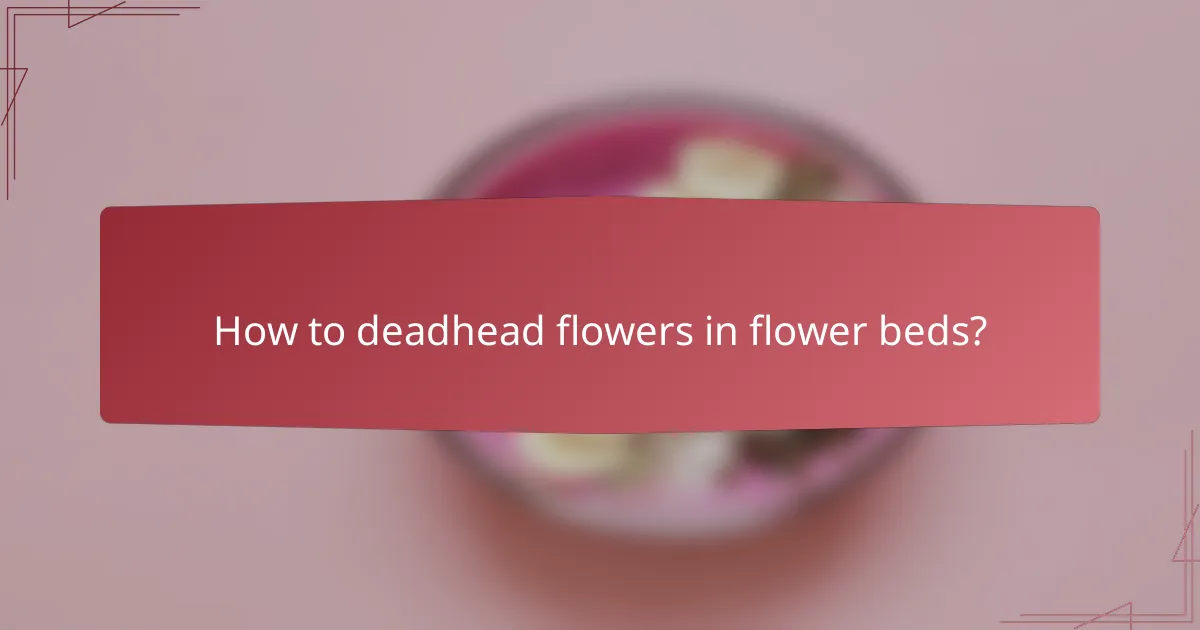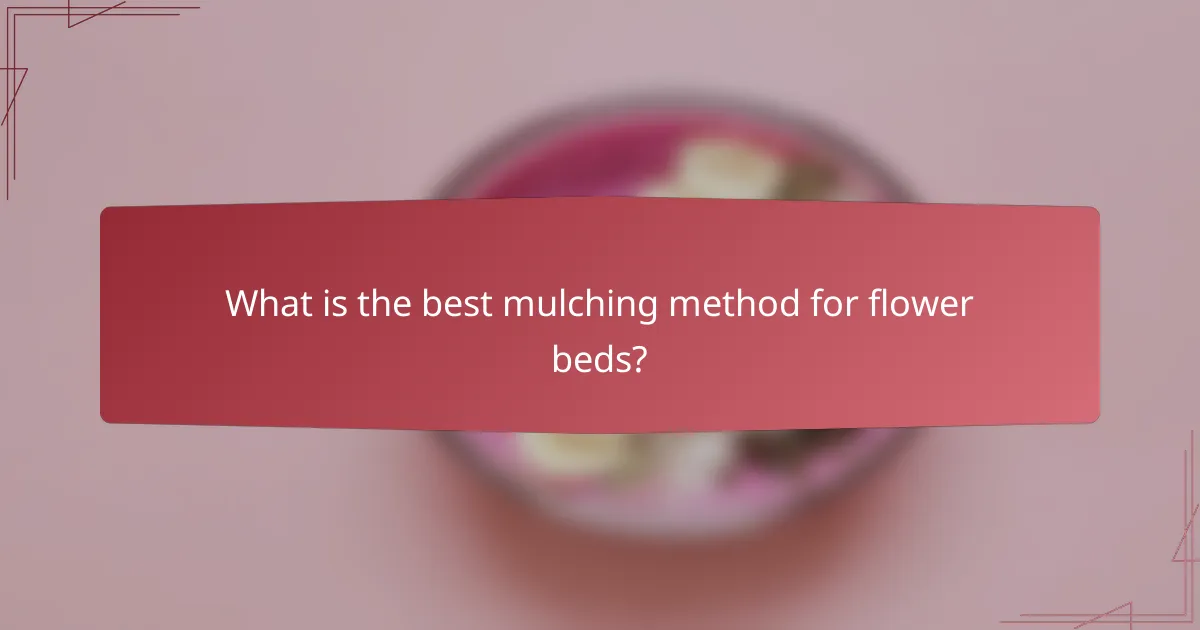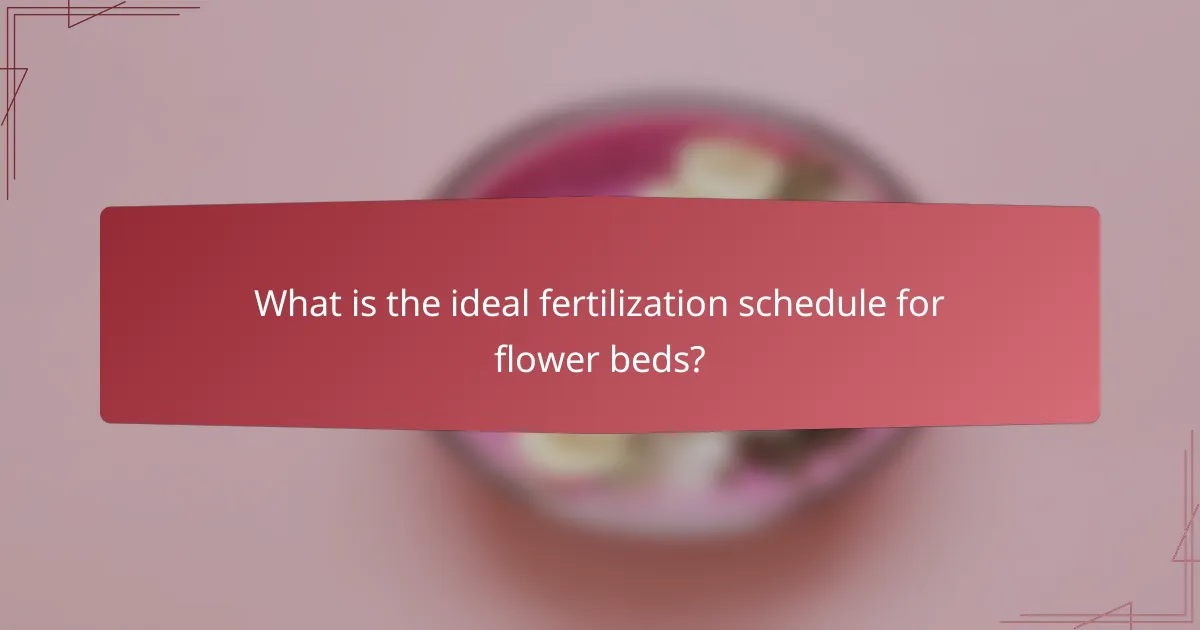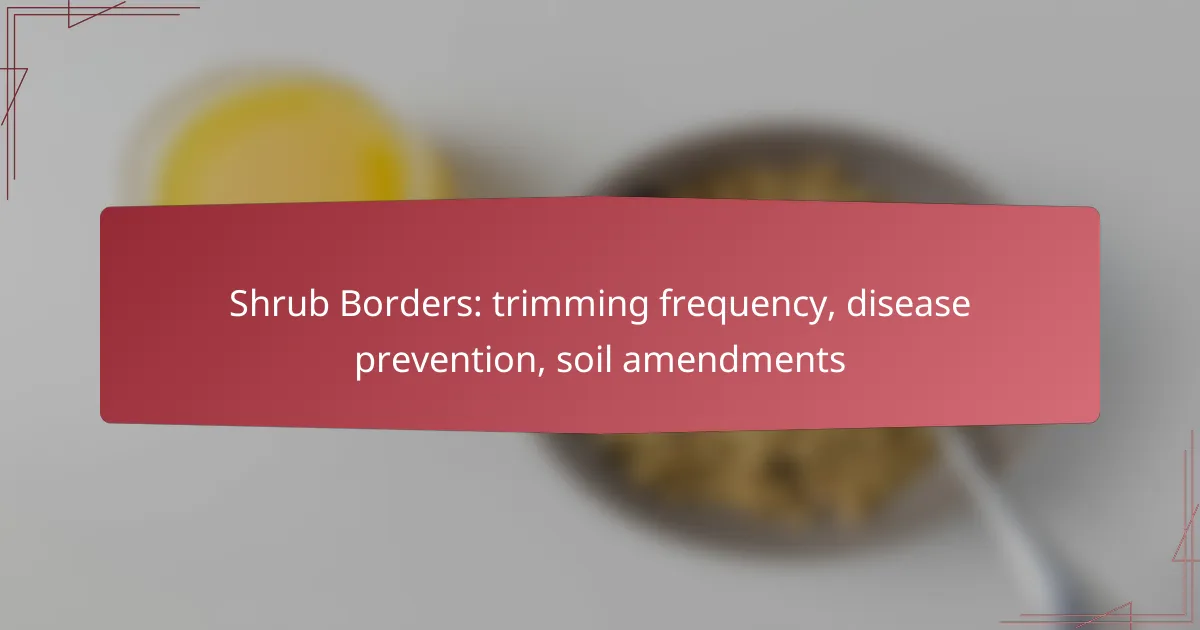Maintaining vibrant flower beds requires attention to key practices such as deadheading, mulching, and a proper fertilization schedule. Deadheading encourages new blooms and keeps your garden looking its best, while mulching helps retain moisture and suppress weeds. Additionally, a consistent fertilization schedule every 4 to 6 weeks during the growing season provides essential nutrients for healthy growth and abundant flowering.

How to deadhead flowers in flower beds?
Deadheading flowers in flower beds involves removing spent blooms to encourage new growth and prolong flowering. This practice helps maintain the aesthetic appeal of your garden and can prevent plants from going to seed, which often leads to a decline in blooming.
Best tools for deadheading
To effectively deadhead flowers, use tools such as sharp scissors or pruning shears. These tools allow for clean cuts that minimize damage to the plant. For larger plants, consider using a hand pruner to reach deeper into the foliage.
Additionally, wearing gardening gloves can protect your hands from thorns or irritants, especially when dealing with certain flower varieties. Keep your tools clean and sharp for the best results.
Recommended techniques for deadheading
When deadheading, aim to cut just above the first set of healthy leaves or buds. This encourages new growth and can lead to a more robust flowering cycle. For some plants, pinching off the spent flowers with your fingers is sufficient and can be quicker.
Be sure to remove any wilted or brown foliage as well, as this can harbor pests or diseases. Regularly inspecting your flower beds will help you stay on top of deadheading tasks.
Timing for deadheading
The best time to deadhead flowers is during the blooming season, ideally in the morning when the plants are hydrated. This timing ensures that the plants are in their best condition for recovery after deadheading.
Monitor your flowers regularly; some may require deadheading every few weeks, while others may only need it once the blooms fade. Adjust your deadheading schedule based on the specific needs of your flower varieties.

What is the best mulching method for flower beds?
The best mulching method for flower beds involves using organic or inorganic materials to cover the soil, which helps retain moisture, suppress weeds, and improve soil health. Choosing the right type of mulch and applying it correctly can significantly enhance the growth and appearance of your flowers.
Types of mulch suitable for flower beds
There are two main categories of mulch: organic and inorganic. Organic mulches include materials like wood chips, straw, grass clippings, and shredded leaves, which decompose over time and enrich the soil. Inorganic options, such as gravel, stones, or landscape fabric, do not break down but provide long-lasting coverage.
When selecting mulch, consider the specific needs of your flower bed. For example, wood chips are great for moisture retention, while gravel can be beneficial for drainage in drier climates.
Benefits of mulching
Mulching offers several advantages for flower beds, including moisture retention, weed suppression, and temperature regulation. By covering the soil, mulch helps maintain consistent moisture levels, reducing the need for frequent watering.
Additionally, a layer of mulch can prevent weeds from germinating, which minimizes competition for nutrients and light. This can lead to healthier plants and a more attractive garden overall.
When to apply mulch
The best time to apply mulch is in the spring after the soil has warmed up but before weeds start to grow. A layer of 2-4 inches is typically recommended to effectively suppress weeds and retain moisture.
In some cases, a second application in the fall can help protect plants during winter. However, avoid piling mulch against plant stems, as this can lead to rot and other issues.

What is the ideal fertilization schedule for flower beds?
The ideal fertilization schedule for flower beds typically involves feeding plants every 4 to 6 weeks during the growing season. This ensures that flowers receive the necessary nutrients to thrive and bloom effectively.
Types of fertilizers for flower beds
There are several types of fertilizers suitable for flower beds, including granular, liquid, and slow-release options. Granular fertilizers are often applied at the beginning of the growing season, while liquid fertilizers can be used for quick nutrient absorption during peak growth periods.
Organic fertilizers, such as compost or well-rotted manure, are also effective and improve soil health over time. Chemical fertilizers provide a quick nutrient boost but should be used carefully to avoid over-fertilization.
Frequency of fertilization
Flower beds generally benefit from fertilization every 4 to 6 weeks from early spring until late summer. This frequency helps maintain consistent nutrient levels in the soil, promoting healthy growth and vibrant blooms.
For specific plants, such as annuals or heavy feeders, consider fertilizing more frequently, while perennials may require less frequent applications. Always follow the manufacturer’s instructions for the best results.
Signs of nutrient deficiency
Common signs of nutrient deficiency in flower beds include yellowing leaves, stunted growth, and poor flowering. If plants appear weak or have discolored foliage, it may indicate a lack of essential nutrients.
For example, nitrogen deficiency often results in yellowing of older leaves, while phosphorus deficiency can cause poor root development and fewer blooms. Regularly monitoring your plants can help identify these issues early, allowing for timely intervention.

What are the local services for flower bed maintenance?
Local services for flower bed maintenance typically include deadheading, mulching, and fertilization. These services help keep flower beds healthy and vibrant, ensuring that plants thrive throughout the growing season.
Top local landscaping services
Many landscaping companies offer specialized flower bed maintenance services. Look for providers that have experience with local flora and understand the specific needs of your garden. Popular services include regular weeding, soil amendment, and seasonal planting.
Some well-regarded local landscaping services may also provide consultation on flower bed design, helping you select the right plants for your environment. Check online reviews and ask for recommendations to find reputable landscapers in your area.
Cost of flower bed maintenance services
The cost of flower bed maintenance services can vary widely based on the scope of work and local market rates. Generally, you might expect to pay anywhere from $50 to $150 for basic services like deadheading and mulching, depending on the size of the flower bed and the complexity of the tasks.
For more comprehensive services, such as fertilization and soil testing, costs can increase. It’s advisable to get quotes from multiple providers to compare prices and services offered. Keep in mind that investing in regular maintenance can lead to healthier plants and reduced costs in the long run.

What are the prerequisites for a healthy flower bed?
To establish a healthy flower bed, it’s essential to focus on soil quality, sunlight exposure, and adequate watering. These factors create a thriving environment for flowers, ensuring they grow strong and vibrant.
Soil testing requirements
Soil testing is crucial for determining the nutrient levels and pH balance of your flower bed. A pH level between 6.0 and 7.0 is generally ideal for most flowering plants. Testing kits are available at garden centers and can provide insights into necessary amendments.
Once you receive the test results, you may need to add organic matter, such as compost, or specific fertilizers to address deficiencies. Regular testing every few years can help maintain optimal soil health.
Sunlight and water needs
Most flowering plants require at least six hours of direct sunlight daily to thrive. When selecting flowers, consider their specific light requirements, as some may prefer partial shade while others need full sun. Position your flower bed accordingly to maximize sunlight exposure.
Watering is equally important; aim for consistent moisture without waterlogging the soil. A general rule is to provide about 1 inch of water per week, either through rainfall or irrigation. Adjust this based on weather conditions and the specific needs of your plants to prevent stress and promote healthy growth.

How do seasonal changes affect flower bed care?
Seasonal changes significantly influence flower bed care by dictating the timing and type of maintenance needed. Different seasons require specific actions, such as deadheading in spring and preparing for winter in fall, to ensure healthy blooms and robust plants.
Spring care tips
In spring, focus on revitalizing your flower beds after winter dormancy. Begin by removing any dead foliage and debris to promote air circulation and prevent disease. Deadheading spent blooms encourages new growth and prolongs flowering.
Consider applying a balanced fertilizer to provide essential nutrients for your plants. A slow-release fertilizer can be beneficial, as it feeds your flowers gradually throughout the growing season. Aim for a fertilization schedule that aligns with your local climate, typically every 4-6 weeks.
Fall preparation strategies
As fall approaches, prepare your flower beds for the upcoming winter months. Start by cutting back perennials and removing any dead plant material to reduce pest and disease issues. Mulching is crucial during this time; apply a layer of organic mulch to insulate the soil and retain moisture.
Additionally, consider planting spring-flowering bulbs in the fall. This not only enhances the beauty of your garden come spring but also helps to improve soil health. Ensure that you mulch around these bulbs to protect them from freezing temperatures.

What are emerging trends in flower bed design?
Emerging trends in flower bed design focus on sustainability, biodiversity, and aesthetic appeal. Homeowners are increasingly opting for native plants, eco-friendly materials, and creative layouts that enhance both beauty and environmental health.
Deadheading
Deadheading is the practice of removing spent flowers to encourage new blooms and maintain plant health. This process helps redirect the plant’s energy from seed production to new growth, resulting in a more vibrant flower bed.
To effectively deadhead, use clean, sharp tools to snip off faded flowers just above the first set of healthy leaves. Regular deadheading can extend the blooming period of many annuals and perennials, making it a key practice for maintaining a lively garden.
Mulching
Mulching involves applying a layer of material on the soil surface to retain moisture, suppress weeds, and enhance soil quality. Organic mulches, such as wood chips or straw, can improve soil structure as they decompose, while inorganic options like gravel provide a clean look.
Apply a 2-4 inch layer of mulch around your flower beds, ensuring it does not touch the stems of the plants. This practice not only conserves water but also reduces the need for frequent weeding and can help regulate soil temperature.
Fertilization Schedule
A fertilization schedule is essential for providing nutrients to your flower beds at the right times. Most flowering plants benefit from a balanced fertilizer applied during the growing season, typically in spring and mid-summer, to promote healthy growth and flowering.
Consider using slow-release fertilizers to provide a steady supply of nutrients over time. Always follow the manufacturer’s instructions regarding application rates, and be cautious not to over-fertilize, as this can lead to excessive foliage growth at the expense of flowers.



